No CrossRef data available.
Article contents
Remarks by Robert E. Herzstein
Published online by Cambridge University Press: 28 February 2017
Abstract

- Type
- International Regulation of Toxic Substances
- Information
- Copyright
- Copyright © American Society of International Law 1979
References
1 See 44 Fed. Reg. 2242 et seq.
2 § 5 also requires premanufacture notification from firms which seek to apply a chemical substance which is on the inventory to a “significant new use.” Rules governing significant new uses (or, in EPA's parlance, SNURs) are not due to be proposed by the Agency until early 1980. Many importers and foreign suppliers are concerned that these rules will also have an adverse impact on trade by imposing on them reporting obligations similar to those imposed by the § 5 regulations, yet on an even broader scale.
3 Among the groups represented were the European Council of Chemical Manufacturers Federations, Ecological and Toxicological Association of the Dyestuffs Manufacturing Industry (ETAD), American Importers Association, European Chemical Industry Manufacturers Assocation (CEFIC), and Confederation of British Industries.
4 The level of concern of the foreign community is reflected in the strongly worded “note verbale” submitted to the State Department by the Commission of the European Communities on March 18, 1979. See 2 BNA International Environment Reporter at 649 (April 11, 1979). An interesting contrast to the note verbale is EPA Administrator Costle's recent speech on the international implications of TSCA, delivered at a BNA International Association of Environmental Coordinators Seminar on April 10, 1979.
5 See K. Dam, The GATT, at 12 (1970).
6 The Trade Act of 1974 also instructs that “the overall United States negotiating objective shall be to obtain more open and equitable market access and the harmonization, reduction or elimination of devices which distort trade or elimination of devices which distort trade or commerce.” § 103, 19 U.S.C. § 2112(a) (1974).
7 Section 3(2)(A) of TSCA defines “chemical substance” as follows: Except as provided in subparagraph (B), the term ‘chemical substance’ means any organic or inorganic substance of a particular molecular identity, including— (i) any combination of such substances occurring in whole or in part as a result of a chemical reaction or occurring in nature, and (ii) any element or uncombined radical. Subparagraph (B) excludes many substances regulated under other federal laws, including pesticides, nuclear material, food, drugs and cosmetics.
8 The term “mixture” is defined in § 3(8) of TSCA.
9 “Article” is a term used but not defined in TSCA. EPA has defined it in its proposed § 5 regulations as follows: An ‘article’ is a manufactured item (1) which is formed to a specific shape or design during manufacture, (2) which has end use function(s) dependent in whole or in part upon its shape or design during end use and (3) which has either no change of chemical composition during its end use or only those changes of composition which have no commercial purpose separate from that of the article and that may occur as described in § 720.13(e)(5), except that fluids and particles are not considered articles regardless of shape or design. § 720.2, 44 Fed Reg. 2264.
10 See 44 Fed. Reg. 2246.
11 Cf. Chrysler Corp. v. Brown et al., 47 U.S.L.W. 4434 (April 18, 1979).
12 Exemption 4 protects “trade secrets and commercial or financial information obtained from a person and privileged or confidential.”
13 See 44 C.F.R. 2275.
14 For an extensive presentation of the domestic chemical industry's position on confidentiality, see “Comments of the Manufacturing Chemists Association on EPA Proposed Regulations for Premanufacture Notification Under § 5 of TSCA,” at 188-205 (March 26,1979).
15 See § 720.2, 44 Fed. Reg. 2265.
16 As a general rule, a federal agency's statutory authority to require information from a party does not have territorial limitations. See, e.g., Montship Lines, Ltd. v. Federal Maritime Board, 295 F.2d 147, 153-54 (D.C. Cir. 1961). See also United States v. First National City Bank, 396 F.2d 897, 900-01 (2d Cir. 1968) (“It is no longer open to doubt that a federal court has the power to require the production of documents located in foreign countries if the court has in personam jurisdiction of the person in possession or control of the material.” )
17 See § 720.21(C), 44 Fed. Reg. 2270.
18 See generally §14 o f the Code. The Committee is given ultimate authority for rendering a final decision. See § 14.7.
19 Under § 2.5 o f the Code, adherents are required to take certain procedural steps to ensure that other adherents have the opportunity to comment on any new technical regulations or standards. EPA's very impressive efforts to inform importers and foreign firms of the § 5 regulations in advance of their proposal, as well as the formal public comment period, clearly satisfy these requirements.
20 Nor would § 7, the provision in the Code governing certification systems literally apply to § 5. Technically, TSCA is not a certification statute, although many firms who commented on EPA's proposed § 5 regulations pointed out that the Agency has essentially imposed elements of a certification system in the regulations.
21 This definition of “manufacture” survived from S.426, the Senate bill first introduced in 1973. Little attention was given to the distinction between manufacturersand importers in the Congressional hearings and debates.


